HR Forecasting Explained: Methods, Challenges & What’s Next
Learn what HR forecasting is, key methods, challenges, and strategies to plan workforce needs and stay ready for future business demands.
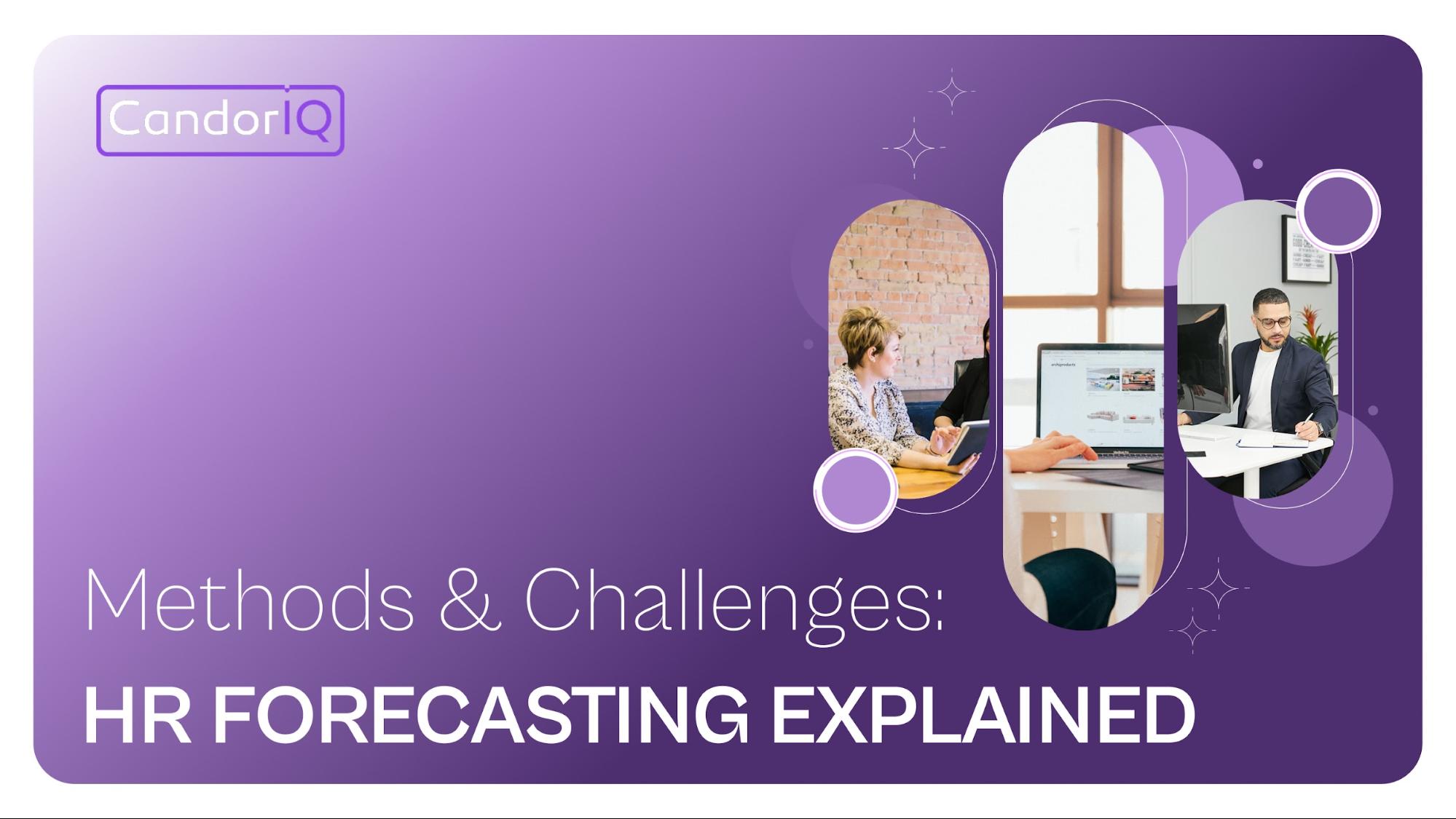
Talent isn’t just an asset, but it’s a competitive edge. That’s why workforce planning is so important. Still, many teams get it wrong. When you’re short-staffed, people burn out and deadlines slip. When you hire too many, costs pile up fast.
We understand how tough it can be to find the right balance, especially when business needs keep shifting and HR is expected to keep up without missing a beat.
That’s where HR forecasting makes a difference. It helps you plan ahead, hire when it counts, and keep your team in step with business needs. It adds structure and lets HR stay ahead of the curve, instead of rushing to catch up.
In this guide, we’ll break down the core methods of HR forecasting, explore common challenges, and look ahead at where the practice is headed.
TL; DR
- Aligns hiring with business growth by ensuring the right talent is in place at the right time.
- Cuts hiring risks through early insight into turnover, skills gaps, and future needs.
- Controls workforce costs with smarter budgeting and targeted training.
- Prepares for change by supporting succession planning and market adaptability.
What is HR Forecasting?
HR forecasting is all about planning ahead for your company’s workforce needs. It’s a proactive approach that looks at your current employee data, business goals, and trends like turnover and skill gaps to help you understand how many people you’ll need. It will also help you know what kind of talent to keep things moving smoothly in the future.
This kind of forward-thinking helps HR teams stay ahead of the curve. With the right insights, they can develop more effective strategies for hiring, training, and retaining the right people.
When done properly, HR forecasting helps avoid two common issues: having too many employees (which can drive up costs unnecessarily) or not having enough (which can slow down productivity and growth).
When workforce planning is aligned with business goals, HR forecasting helps make sure the right people are in the right roles at the right time. It’s a practical way to support long-term growth, manage costs, and build a people strategy that truly works for the company's future.
Now that you know what HR forecasting means, it’s helpful to understand why it’s important for businesses today.
Importance of HR Forecasting
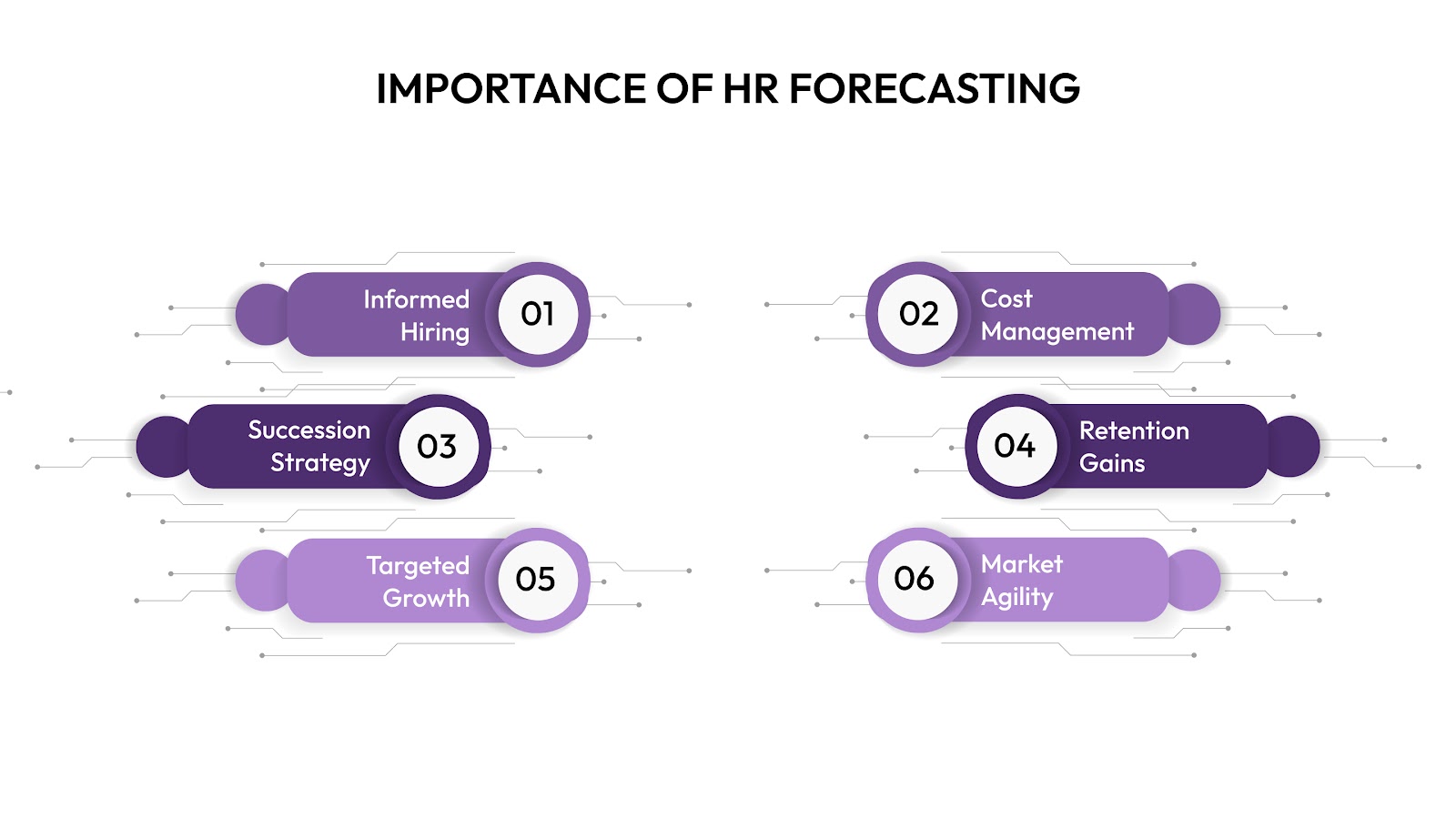
HR forecasting plays a key role in helping organizations stay ahead of their workforce needs. It ensures that talent planning stays in sync with business goals, helping teams prepare for future challenges and opportunities in a proactive way.
By predicting hiring demands, identifying skill gaps, and managing workforce transitions smoothly, HR forecasting helps reduce talent shortages, control costs, and support long-term growth.
HR forecasting helps in:
- Smarter Hiring Decisions: Forecasting helps you plan recruitment based on real staffing needs. Instead of rushing to fill roles, you can attract and hire the right people at the right time. It avoids delays that could slow down business operations.
- Better Control Over Costs: When you know what’s coming, you can budget more effectively. Forecasting prevents overspending on unnecessary hires or overtime resulting from understaffing. It’s a practical way to manage workforce expenses wisely.
- Stronger Succession Planning: Forecasting helps identify critical roles and spot potential leadership gaps early. That means you can start developing internal talent well in advance, ensuring smooth transitions when top talent moves on or retire.
- Boosted Employee Retention: By identifying turnover trends, HR teams can take proactive action to retain top performers. This reduces the disruption and cost of constant rehiring and builds a more stable workforce.
- Focused Training and Development: HR forecasting shows where skill gaps might appear in the future. That insight lets you roll out targeted training programs, helping employees grow into future roles and keeping your team ready for what’s next.
- More Agility in a Changing Market: With solid forecasting, your company can respond quickly to industry shifts, economic changes, or internal growth. It keeps your people strategy flexible and future-ready.
Knowing why HR forecasting matters is just the beginning. To put it into practice, it’s important to understand the key components that make it work effectively.
Key Components of HR Forecasting
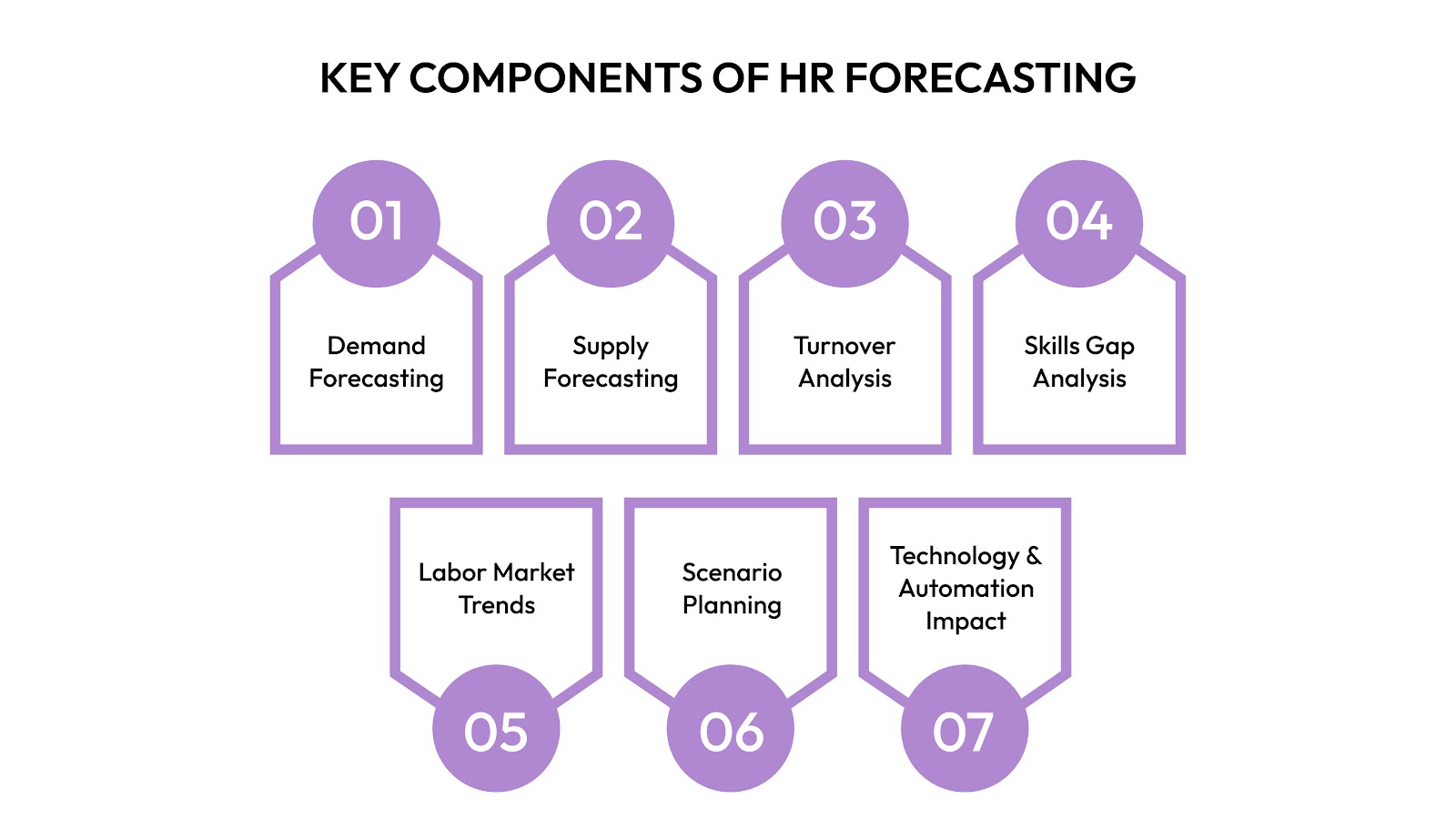
HR forecasting is the practice of planning ahead to meet your organization’s future talent needs. But to forecast effectively, you need to understand the key concepts that drive this process.
These components help HR teams align workforce planning with business goals and ensure the organization is ready for what’s ahead. Here’s a breakdown of the key elements:
- Demand Forecasting: This is about predicting how many employees the company will need in the future, and what kind of skills they should have. Whether it’s for business expansion, a new project, or seasonal growth, demand forecasting helps HR plan the “who,” “when,” and “what” of hiring so the right people are in place when needed
- Supply Forecasting: This focuses on your current team. It examines who is likely to stay, retire, get promoted, or leave. By analyzing these factors, HR can get a realistic picture of future talent availability and figure out where gaps might emerge.
- Turnover Analysis: By studying past patterns of employee exits, both voluntary and involuntary, HR can better predict when and where turnover might spike. This insight helps the company prepare ahead with recruitment, retention efforts, or internal mobility plans.
- Skills Gap Analysis: This involves comparing the skills your team has today with the skills they’ll need in the future. If there’s a gap, HR can decide whether to train existing employees or bring in new talent. It’s essential to ensure your workforce is always prepared to handle upcoming challenges.
- Labor Market Trends: External factors, like talent shortages, economic shifts, or changes in your industry, also influence workforce planning. Staying up to date with labor market trends helps HR adjust hiring strategies, compensation plans, and overall workforce priorities as needed.
- Scenario Planning: No one can predict the future perfectly, but scenario planning helps you prepare for different possibilities. Whether it’s a sudden market shift or rapid company growth, mapping out multiple “what if” situations allows HR to stay flexible and ready to act.
- Technology and Automation Impact: As automation and AI continue to evolve, HR needs to factor in how technology will change job roles and skill requirements. Forecasting helps companies plan ahead for reskilling, upskilling, or restructuring roles so the workforce keeps up with innovation.
Once the key components are in place, the focus turns to how forecasting is actually done. This is where different HR forecasting methods come into play.
HR Forecasting Methods
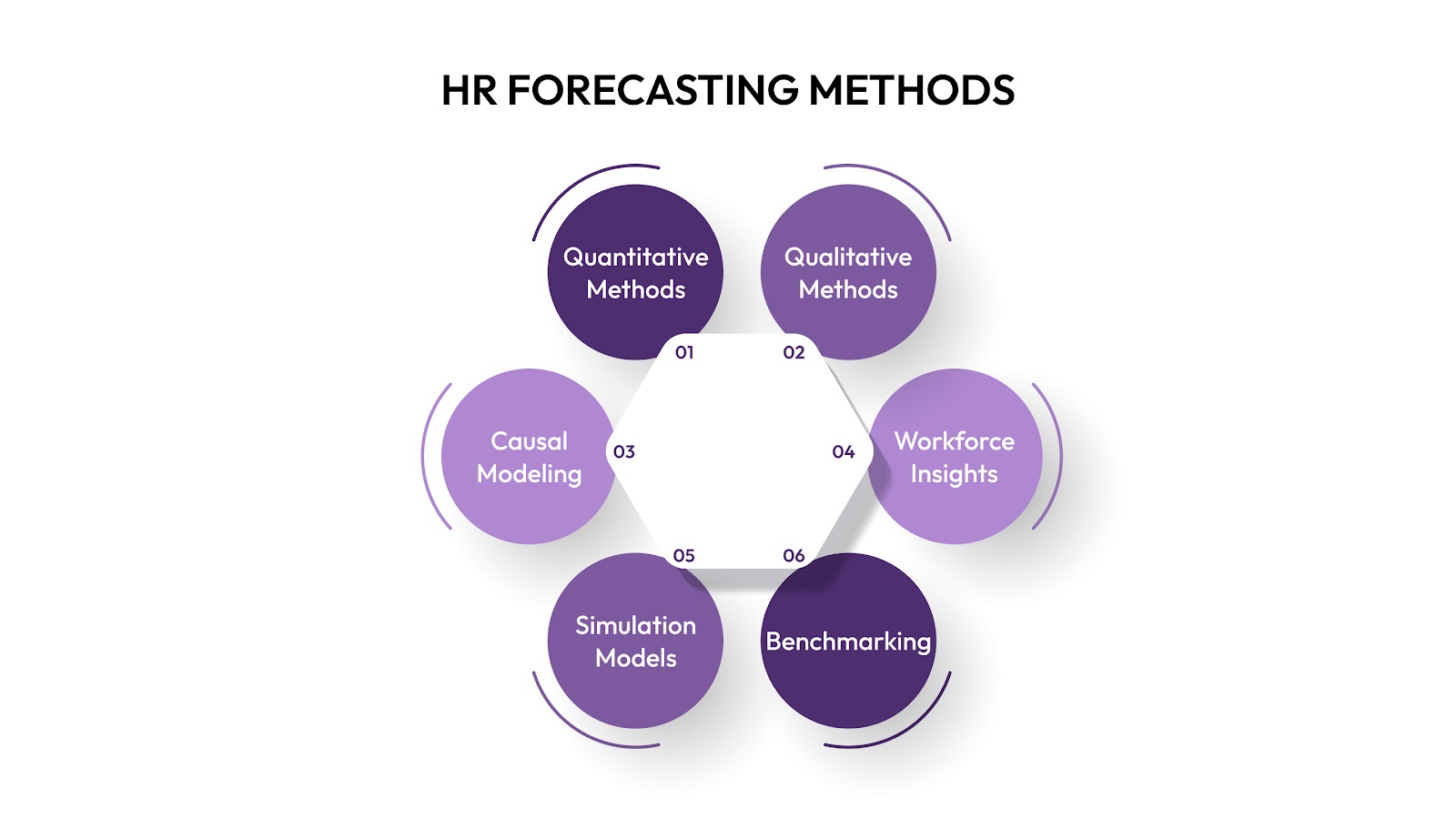
Choosing the right method is an important part of effective HR forecasting. Different situations call for different approaches, whether you're planning for rapid growth, navigating high turnover, or preparing for new skill demands.
HR forecasting methods help organizations estimate future workforce needs using both qualitative insights and quantitative data. Each method offers a unique lens for projecting and preparing for what’s ahead in talent management.
Here are some of the most commonly used methods:
1. Quantitative Methods
These methods use numbers, historical data, and statistical models to make forecasts. They work best when you have solid data from previous years. Quantitative methods include:
Trend Analysis
This method looks at past patterns, like hiring rates, turnover, or employee growth, to predict future needs. It assumes that trends will continue unless major changes occur. Trend analysis analyzes historical data to spot trends and apply them to future projections.
For example, if a company has hired 100 employees each year for the past five years, it might plan to hire a similar number next year, adjusting for growth or change.
Ratio Analysis
This approach uses ratios (like employee-to-sales or employee-to-output) to forecast workforce needs as business metrics shift. It establishes ratios based on past performance and applies them to predict future needs.
For example, if the sales team grows by 10% and the sales-to-employee ratio remains 1:100, HR may need to hire 10 more employees to maintain the same performance levels.
2. Qualitative Methods
These rely on expert judgment, insights from managers, and internal discussions. They’re useful when historical data is limited or when facing significant changes. Qualitative methods include:
Delphi Technique
The Delphi technique gathers input from a panel of experts (e.g., senior HR managers, business leaders) to generate predictions about future workforce needs.
The process involves multiple rounds of surveys or interviews, with experts providing their opinions anonymously and receiving feedback after each round. The goal is to reach a consensus on the forecast.
Experts respond to surveys, review group feedback, and refine their inputs until agreement is reached. For instance, a group of managers might predict the need for more sales staff based on upcoming product launches and market demand.
Managerial Judgment
Managerial judgment involves gathering input from key managers and decision-makers within the organization. These managers, who understand the day-to-day challenges and opportunities of their departments, provide insights into future HR needs. Their needs are based on their knowledge of business strategies and operational demands.
Managers provide their own forecasts based on what they see happening in their teams. For instance, a tech manager may anticipate needing five more developers due to a new software project starting soon.
3. Causal Modeling
This method involves identifying and analyzing the relationships between different variables that impact workforce needs. It uses statistical models to forecast HR requirements based on various internal and external factors.
The factors could be economic trends, organizational growth, technological advancements, or changes in industry regulations.
Causal modeling identifies cause-effect relationships (e.g., revenue increases leading to more hiring) and uses them to forecast. For instance, if revenue grows by 10%, the model might predict a need for 5% more employees to handle the extra workload.
4. Predictive Workforce Analytics
Workforce analytics involves using advanced data analytics and machine learning to predict future HR needs. This method uses large datasets, employee behavior patterns, and predictive algorithms to forecast outcomes like turnover, recruitment, and retention.
Predictive analytics can identify patterns and trends that are not immediately obvious, allowing HR to make data-driven decisions about workforce planning.
Predictive analytics software analyzes patterns in employee data (e.g., turnover, engagement) to predict future scenarios. For example, predictive analytics might flag which employees are at high risk of leaving, allowing HR to plan replacements or retention efforts early.
CandorIQ’s predictive analytics also help budget-sensitive CFOs and FP&A leaders gain visibility into workforce costs and ensure financial predictability across business units.
5. Simulation Models
Simulation models involve creating “what-if” scenarios to see how different changes might affect workforce needs. By simulating different conditions (e.g., increased business demand, market downturns, technological changes), HR can assess how these factors would impact workforce needs and make more informed decisions.
For example, a simulation might show how hiring needs would change if customer demand doubled over the next year.
6. Benchmarking
Benchmarking involves comparing an organization's HR practices and workforce metrics with industry standards or competitors. This method helps HR departments understand how their workforce practices align with those of similar organizations. This enables them to forecast workforce needs based on external industry trends.
HR reviews benchmarks (like staffing levels, compensation, or turnover rates) from similar organizations to inform strategy. For example, if competitors are hiring more customer service reps due to increased demand, your company might consider doing the same.
Understanding the methods gives a clear picture of the tools. Now, lets see them into action.
Also Read: Top Benefits of a Talent Management System for Growing Organizations.
How to Implement HR Forecasting
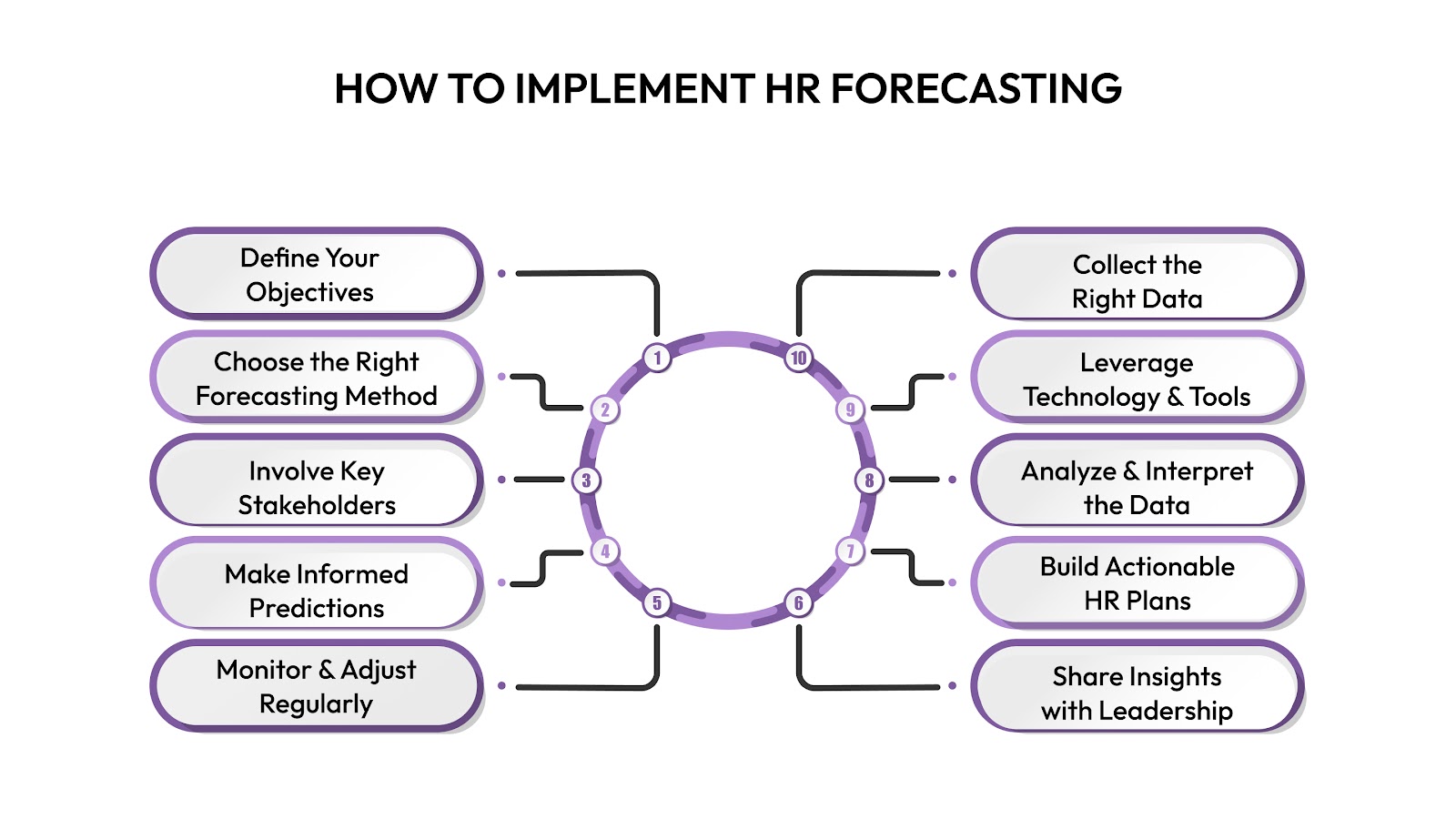
Implementing HR forecasting involves taking a thoughtful and strategic approach that ties workforce planning to your company’s broader objectives. By combining data, technology, and collaboration, HR teams can forecast future talent needs and make smarter, more proactive decisions.
Here’s a step-by-step guide on implementing HR forecasting:
1. Define Your Objectives
Start by getting clear on why you’re forecasting. Are you planning for growth, managing turnover, developing future leaders, or bridging skill gaps? Knowing your goals upfront ensures that your HR forecast supports the company’s broader strategy.
You need to align forecasting goals with business objectives. Additionally, identify what you want to forecast, such as headcount, skills, leadership roles, or turnover trends.
2. Collect the Right Data
Strong forecasting depends on reliable data. Pull historical HR data like turnover, hiring trends, employee demographics, performance, and promotions. Don’t forget to include external insights like labor market trends and economic indicators.
You can use internal sources like your HRIS, payroll, and performance systems. Look at age, tenure, department size, and upcoming retirements. Also, add in external data like industry trends or local talent availability.
3. Choose the Right Forecasting Method
Not every method fits every business. If you have solid data, consider using quantitative methods, such as trend or ratio analysis. If things are in flux, consider seeking expert input or engaging in scenario planning.
You should use quantitative methods (trend, ratio, predictive analytics) for data-driven insights. Or use qualitative methods (such as manager input and the Delphi technique) when historical data are limited. You can also combine both for a balanced approach.
4. Leverage Technology and Tools
Forecasting manually can be time-consuming. Using HR tech and analytics platforms can simplify the process and boost accuracy.
You should invest in tools like SAP SuccessFactors, Workday, or PeopleSoft. Use predictive analytics tools to spot patterns and trends. In addition, build dashboards to visualize data and share insights across teams.
5. Involve Key Stakeholders
HR can’t forecast in a vacuum. Loop in other departments, especially finance, operations, and leadership, so your forecasts are realistic and aligned with company needs.
You should collaborate with department heads to understand the team's specific needs. Work with finance to align forecasts with budgets. Also, get buy-in from leadership to drive action based on the data.
6. Analyze and Interpret the Data
Once you have the data and your chosen method, it’s time to dig in. Look for trends, patterns, and changes in workforce behavior to shape your forecast. You can:
- Track turnover, absenteeism, hiring, and promotions over time.
- Use visual tools like charts and dashboards for better clarity.
- Factor in external changes like labor laws or economic shifts.
7. Make Informed Predictions
Now you can use your findings to forecast workforce needs, who you'll need, what roles will grow, and where potential gaps may appear. You can:
- Estimate future headcount by team, role, or location.
- Forecast potential turnover or hiring spikes.
- Account for trends like remote work or digital skill demand.
8. Build Actionable HR Plans
Turn those predictions into practical steps. From hiring and training to succession and retention, your forecast should lead to real, measurable HR strategies.
Create recruitment plans to meet projected needs and develop training programs to close skill gaps. Also, set retention goals for high-risk roles or departments.
9. Monitor and Adjust Regularly
Forecasts aren’t one-and-done. You need to continue tracking, reviewing, and refining your data to stay aligned with business changes.
Set a regular cadence to review your forecasts (e.g., quarterly) and adjust plans based on real-time performance and market shifts. Additionally, gather feedback from managers and employees to enhance accuracy.
10. Share Insights with Leadership
Finally, communicate your findings clearly. When leadership understands what’s coming, they can make more strategic decisions, and HR can be seen as a key business partner.
You should present forecasts and action plans in clear, visual formats. Highlight key risks and opportunities tied to workforce planning. Also, use data to support decisions on budgets, hiring, and training.
Even with a solid implementation plan, HR forecasting can come with its own share of challenges.

Challenges of HR Forecasting & Its Effective Solutions
HR forecasting plays a vital role in helping organizations plan for their future workforce needs. But like any strategic process, it comes with its share of challenges.
From data issues to unpredictable external factors, these hurdles can affect the accuracy and value of your forecasts. Let’s take a look at some of the most common challenges and how you can effectively address them.
Addressing common challenges is a big step forward, but sustaining success requires the right strategies.
Strategies for Effective HR Forecasting
Accurate HR forecasting helps organizations stay ahead by ensuring they have the right people, with the right skills, at the right time. But effective forecasting is about aligning with business goals, embracing data, and staying flexible in a changing world.
Here are some practical strategies to enhance your HR forecasting process:
- Align Forecasting with Business Goals: Collaborate with leadership and key stakeholders to understand growth plans. Align workforce forecasts with strategic priorities like innovation or market entry. Update forecasts regularly to reflect shifting business objectives.
- Use Data and Analytics for Smarter Forecasting: Gather data from HR systems, performance reviews, and labor market sources. Use predictive analytics to identify trends and forecast future needs. Monitor data continuously and adjust forecasts as needed.
- Plan for Multiple Scenarios: Create different forecasting models based on possible business scenarios (e.g., economic growth, tech disruptions). Develop contingency plans for hiring, training, or reskilling. Revisit scenarios regularly as conditions evolve.
- Use Workforce Planning Software: Choose software like CandorIQ that integrates with your HRIS and supports forecasting features. Track workforce metrics like turnover, hiring trends, and performance. Use dashboards to visualize insights and share them across teams.
- Collaborate Across Departments: Meet regularly with department heads to understand upcoming needs. Involve finance teams to align plans with budgets. Consider inputs like tech upgrades or project launches that affect staffing.
- Forecast for Skills. Not Just Headcount: Conduct skills gap analyses to understand current and future skill needs. Build training and upskilling into your workforce plans. Partner with external talent sources to access niche or emerging skills.
- Monitor Labor Market Trends: Track trends in salaries, demand for specific roles, and unemployment rates. Keep an eye on what competitors are doing in recruitment and compensation. Stay updated on policy changes that affect labor and hiring.
- Continuously Review and Refine Forecasts: Set a regular schedule (e.g., quarterly) to review and update forecasts. Collect feedback on forecast accuracy and adjust plans accordingly. Track key metrics like turnover, time-to-hire, and training outcomes.
Having the right strategies in place strengthens today’s workforce planning, but HR forecasting continues to evolve.
The Future of HR Forecasting
As businesses continue to adapt to fast-changing technologies, evolving employee expectations, and new ways of working, HR forecasting is becoming smarter, faster, and more strategic.
HR teams are now focusing on building a workforce that’s not only the right size but also equipped with the right skills to drive long-term success. From AI-driven insights to flexible workforce models, the future of HR forecasting is all about staying ahead of change.
Here are some of the top trends and predictions that are shaping where HR forecasting is headed next:
AI and Machine Learning Are Changing the Game
AI and machine learning are already helping HR teams analyze data faster, spot trends, and make smarter predictions, whether it’s about turnover, skill gaps, or future hiring needs.
These tools will become even more powerful and widely used. HR teams will be able to uncover insights from massive datasets, anticipate risks before they happen, and take proactive action, like rolling out targeted training or retention programs.
Predictive Analytics for Smarter Workforce Planning
Predictive analytics is already helping organizations move from reactive to proactive workforce planning. It uses historical and market data to forecast trends.
HR won’t just predict how many people are needed, but also which roles, departments, and skills will be essential. This helps businesses stay ready for change, whether it’s new tech, shifting customer needs, or growth plans.
Real-Time Forecasting, Not Just Annual Planning
Traditional forecasting often happens once or twice a year. However, that approach can feel outdated in a rapidly evolving world.
HR forecasting will become a real-time, ongoing process. With better tools and live dashboards, HR teams can track workforce changes, market shifts, and internal trends as they happen and update their plans immediately.
For instance, if a spike in turnover is detected in one team, real-time alerts can trigger a response, like investigating the cause or fast-tracking replacement hiring.
Shift from Headcount to Skills Forecasting
Companies are realizing that it’s not just about how many people they need; it’s about what skills they need. This is especially true as technology continues to evolve.
HR will focus more on forecasting skill sets rather than just roles. This enables better training, upskilling, and smarter hiring to keep pace with the changing landscape.
For instance, a tech company may forecast a future need for more AI or cybersecurity experts and start building internal programs or hiring plans around those skills.
Deeper Integration with Business Intelligence Tools
HR teams are starting to use BI tools to connect their workforce data with sales, finance, and operations insights. HR forecasting will be guided by broader business performance, helping leaders make workforce decisions that support real business outcomes.
For example, by linking sales growth forecasts with hiring plans, HR can ensure that enough customer-facing staff are onboarded in time to support demand.
Forecasting Will Be More Employee-Centric
HR forecasting will use tools like engagement surveys, feedback platforms, and behavioral analytics to predict who might leave and why. That way, teams can act early to boost satisfaction and retention.
If predictive tools show rising disengagement in a certain department, HR can roll out manager training or conduct listening sessions before employees start leaving.
Forecasting will include insights into representation, inclusion gaps, and diversity targets, helping companies build more inclusive teams at every level.

Final Words
Effective HR forecasting is more than just estimating headcount; it's a strategic process that connects workforce planning with business goals. By understanding its key components, applying the right methods, and leveraging both data and collaboration, you can better anticipate talent needs and reduce the risks of overstaffing or understaffing.
The future belongs to businesses that can plan ahead. With thoughtful HR forecasting, you’re not just reacting to change; you’re prepared for it.
Candoriq offers advanced analytics and talent management solutions to help you identify skill gaps, forecast future workforce needs, and create personalized development plans.
With our data-driven insights, you can optimize your HR forecasting, align your talent strategy with business goals, and drive sustainable growth. Contact us today to transform your workforce planning into a competitive advantage.
Also Read: Compensation Management Software Guide for HR Teams in 2025.
FAQs
Q1. How does HR forecasting support business growth?
A1. HR forecasting ensures you have the right people in place as your business grows. Aligning your talent strategy with long-term goals helps prevent skill shortages and supports smoother, more confident expansion.
Q2. Does HR forecasting improve employee retention?
A2. Yes, it does. By spotting potential gaps early, HR forecasting allows you to invest in employee development. This opens up growth opportunities for your team, increases engagement, and helps retain top talent.
Q3. What are the long-term advantages of HR forecasting?
A3. Over time, HR forecasting strengthens your organization by keeping you ready for change. It supports succession planning, reduces hiring risks, and promotes steady, sustainable workforce growth.
Q4. Is HR forecasting useful for small businesses?
A4. Absolutely. Even small businesses can benefit by planning ahead for hiring needs, setting accurate budgets, and avoiding common issues like overstaffing or understaffing as they scale.


